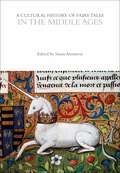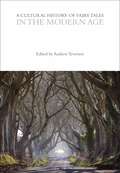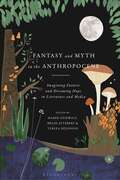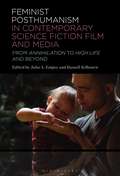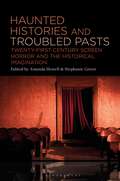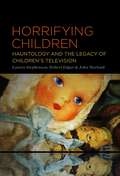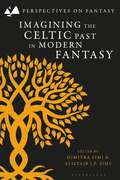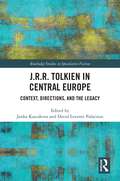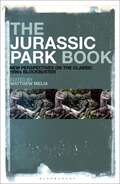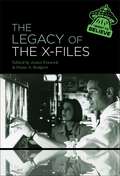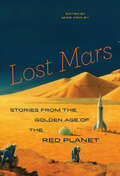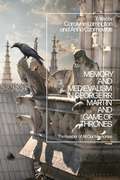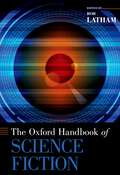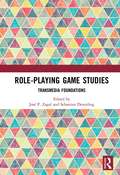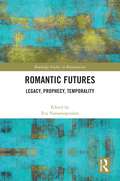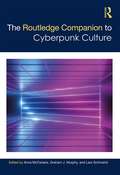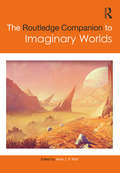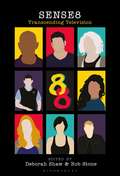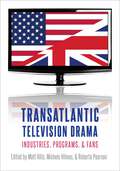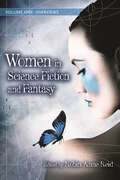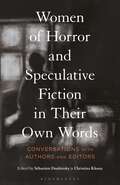- Table View
- List View
A Cultural History of Fairy Tales in the Middle Ages (The Cultural Histories Series)
How have fairy tales from around the world changed over the centuries? What do they tell us about different cultures and societies? Spanning the years from 900 to 1500 and traversing geographical borders, from England to France and India to China, this book uniquely examines the tales told, translated, adapted and circulated during the period known as the Middle Ages. Scholars in history, literature and cultural studies explore the development of epic tales of heroes and monsters and enchanted romance narratives. Examining how tales evolved and functioned across different societies during the Middle Ages, this book demonstrates how the plots, themes and motifs used in medieval tales influenced later developments in the genre. An essential resource for researchers, scholars and students of literature, history and cultural studies, this volume explores themes including: forms of the marvelous, adaptation, gender and sexuality, humans and non-humans, monsters and the monstrous, spaces, socialization, and power.A Cultural History of Fairy Tales (6-volume set)A Cultural History of Fairy Tales in Antiquity is also available as a part of a 6-volume set, A Cultural History of Fairy Tales, tracing fairy tales from antiquity to the present day, available in print, or within a fully-searchable digital library accessible through institutions by annual subscription or on perpetual access (see www.bloomsburyculturalhistory.com). Individual volumes for academics and researchers interested in specific historical periods are also available digitally via www.bloomsburycollections.com.
A Cultural History of Fairy Tales in the Modern Age (The Cultural Histories Series)
How have fairy tales from around the world changed over the centuries? What do they tell us about different cultures and societies?Drawing together contributions from an international range of scholars in history, literature, and cultural studies, this volume uniquely examines creative applications of fairy tales in the twentieth and twenty-first centuries. It explores how the fairy tale has become a genre that flourishes on film, on TV, and in digital media, as well as in the older technologies of print, performance, and the visual arts. An essential resource for researchers, scholars and students of literature, history, the visual arts and cultural studies, this book explores such themes and topics as: forms of the marvelous, adaptation, gender and sexuality, humans and non-humans, monsters and the monstrous, spaces, socialization, and power.A Cultural History of Fairy Tales (6-volume set)A Cultural History of Fairy Tales in Antiquity is also available as a part of a 6-volume set, A Cultural History of Fairy Tales, tracing fairy tales from antiquity to the present day, available in print, or within a fully-searchable digital library accessible through institutions by annual subscription or on perpetual access (see www.bloomsburyculturalhistory.com). Individual volumes for academics and researchers interested in specific historical periods are also available digitally via www.bloomsburycollections.com.
Fantasy and Myth in the Anthropocene: Imagining Futures and Dreaming Hope in Literature and Media
The first study to look at the intersection of the discourse of the Anthropocene within the two highly influential and perennially popular storytelling modes of fantasy and myth, this book articulates the idea that if humanity is to have a future, it needs stories that articulate visions of a biocentric, ecological civilization. As the two story systems that have been humanity's most advanced technologies for collective dreaming, fantastic fiction and myths are helping us adopt a biocentric lens, re-kin us with other forms of life, and assist us in the transition to an ecological civilization. Deliberately moving away from dystopian narratives toward anticipatory imaginations of sustainable futures, this volume blends chapters by top scholars in the fields of climate fiction, science fiction, fantasy, myth, and Young-Adult literature studies with personal reflections by award-winning authors and illustrators of speculative fiction for young audiences such as Jeff Vandermeer, Shaun Tan, Jane Yolen, Katherine Applegate and Joseph Bruchac.Covering the works of major fantasy authors such as J. R. R. Tolkien, Terry Prachett, J. K. Rowling, China Mieville, Barbara Henderson, Jeanette Winterson, John Crowly, Richard Powers, George R. R. Martin and Kim Stanley Robinson, and offering interrogations of cultural expressions set in or from the UK, USA, Nigeria, Ghana, Pacific Islands, New Zealand and Australia, this book frames fantasy and myth as spaces where visions of sustainable futures can be designed with most detail and nuance. Rather than merely criticizing the ecocidal status quo, the book asks how Fantastic stories can mobilize resistance around ideas necessary for the emergence of an ecological civilization.
Feminist Posthumanism in Contemporary Science Fiction Film and Media: From Annihilation to High Life and Beyond
Feminist Posthumanism in Contemporary Science Fiction Film and Media: From Annihilation to High Life and Beyond places posthumanism and feminist theory into dialogue with contemporary science fiction film and media. This essay collection is intimately invested in the debates around the posthuman and the critical posthumanities within a feminist critical-theoretical framework.In this posthumanist light, science fiction as a genre allows for new imaginings of human-technological relations, while it can also be the site of a critique of human exceptionalism and essentialism. In this way, science fiction affords unique opportunities for the scholarly investigation of the relevance and relative applicability of specific posthumanist themes and questions in a particularly rich and wide-ranging popular cultural field of production. One of the reasons for this suitability is the genre's historically longstanding relationship with the critical investigation of gender, specifically the position and relative empowerment of women. The original analyses presented here pay close attention to audiovisual style (including game mechanics), facilitating the critical interrogation of the issues and questions around posthumanism. Where typically the mention of SF in the posthumanist context calls to mind a whole set of (often clichéd) tropes-the cyborg, technologically augmented bodies, AI subjectivities, etc.-this volume's thirteen chapters analyze specific examples of contemporary SF cinema that engage in meaningful ways with the burgeoning field of critical posthumanism, and that utilize such films to interrogate posthumanist and feminist as well as humanistic ideas.
Haunted Histories and Troubled Pasts: Twenty-First-Century Screen Horror and the Historical Imagination
Haunted Histories and Troubled Pasts speaks to how a transnational array of recent screen entertainments participate, through horror, in public discourses of history, the social and creative work of reshaping popular understanding of our world through the lens of the past.Contemporary film and television – and popular screen cultures more generally – are distinguished by their many and varied engagements with history, including participation in worldwide movements to reconcile past losses and injuries with present legacies. The chapters in this collection address themselves to 21st-century screen horror's participation in this widespread fascination with and concern for the historical - its recurrent reimagining of the relation between the past and present, which is part of its inheritance from the Gothic. They are concerned with the historical work of horror's spectral occupations, its visceral threats of violence and its capacity for exploring repressed social identities, as well as the ruptures and impositions of colonization and nationhood.Trauma is a key theme in this book, examined through themes of war and genocide, ghostly invasions, institutionalized abuse, apocalyptic threat and environmental destruction. These persistent, fearful reimaginings of the past can take many lurid – sometimes tritely generic – forms. Together, these chapters explore and reflect upon horror's ability to speak through them to the unspoken of history, to push the boundaries and probe the fault-lines and ideological impositions of received historical narratives – while reminding us that history and the historical imagination persist as sites of contention.
Horrifying Children: Hauntology and the Legacy of Children’s Television
Horrifying Children examines weird and eerie children's television and literature via critical analysis, memoir and autoethnography.There has been an explosion of interest in the impact of children's television and literature of the late twentieth century. In particular, the 1970s, '80s and '90s are seen as decades that shaped a great deal of the contemporary cultural landscape. Television of this period dominated the world of childhood entertainment, drawing freely upon literature and popular culture, like the Garbage Pail Kids and Stranger Things, and much of it continues to resonate powerfully with the generation of cultural producers (fiction writers, screenwriters, directors, musicians and artists) that grew up watching the weird, the eerie and the horrific: the essence of 21st-century Hauntology. In these terms this book is not about children's television as it exists now, but rather as it features as a facet of memory in the 21st century. As such it is the legacy of these television programmes that is at the core of Horrifying Children. The 'haunting' of adults by what we have seen on the screen is crucial to the study. This collection directly addresses that which 'scared us' in the past insomuch as there is a correlation between individual and collective cultural memory, with some chapters providing an opportunity for situating existing explorations and understandings of Gothic and Horror TV within a hauntological and experiential framework.
Imagining the Celtic Past in Modern Fantasy (Perspectives on Fantasy)
Focusing on representations of Celtic motifs and traditions in post-1980s adult fantasy literature, this book illuminates how the historical, the mythological and the folkloric have served as inspiration for the fantastic in modern and popular culture of the western world. Bringing together both highly-acclaimed works with those that have received less critical attention, including French and Gaelic fantasy literature, Imagining the Celtic Past in Modern Fantasy explores such texts as Susanna Clarke's Jonathan Strange & Mr Norrell, Alan Garner's Weirdstone trilogy, the Irish fantasies of Jodi McIsaac, David Gemmell's Rigante novels, Patricia Kennealy-Morrison Keltiad books, as well as An Sgoil Dhubh by Iain F. MacLeòid and the Vertigen and Frontier series by Léa Silhol. Lively and covering new ground, the collection examines topics such as fairy magic, Celtic-inspired worldbuilding, heroic patterns, classical ethnography and genre tropes alongside analyses of the Celtic Tarot in speculative fiction and Celtic appropriation in fan culture. Introducing a nuanced understanding of the Celtic past, as it has been informed by recent debates in Celtic studies, this wide-ranging and provocative book shows how modern fantasy is indebted to medieval Celtic-language texts, folkloric traditions, as well as classical sources.
J.R.R. Tolkien in Central Europe: Context, Directions, and the Legacy (Routledge Studies in Speculative Fiction)
This volume is a long overdue contribution to the dynamic, but unevenly distributed study of fantasy and J.R.R. Tolkien’s legacy in Central Europe. The chapters move between and across theories of cultural and social history, reception, adaptation, and audience studies, and offer methodological reflections on the various cultural perceptions of Tolkien’s oeuvre and its impact on twenty-first century manifestations. They analyse how discourses about fantasy are produced and mediated, and how processes of re-mediation shape our understanding of the historical coordinates and local peculiarities of fantasy in general, and Tolkien in particular, all that in Central Europe in an age of global fandom. The collection examines the entanglement of fantasy and Central European political and cultural shifts across the past 50 years and traces the ways in which its haunting legacy permeates and subverts different modes and aesthetics across different domains from communist times through today’s media-saturated culture.
The Jurassic Park Book: New Perspectives on the Classic 1990s Blockbuster
The definitive 1990s blockbuster, Steven Spielberg's Jurassic Park met with almost universal critical and popular acclaim, broke new ground with its CGI recreation of dinosaurs, and started one of the most profitable of all movie franchises. To mark the film's 30th anniversary, this exciting illustrated collection of new essays interrogates the Jurassic Park phenomenon from a diverse range of critical, historical, and theoretical angles. The primary focus is on Jurassic Park itself but there is also discussion of the franchise and its numerous spin-offs.As well as leading international scholars of film studies and history, contributors include experts in special effects, science on screen, fan studies, and palaeontology. Comprehensive, up to date, and accessible, The Jurassic Park Book appeals not only to students and scholars of Hollywood and contemporary culture, but also to the global audience of fans of the greatest of all dinosaur movies.
The Legacy of The X-Files
The Legacy of The X-Files examines the content and production of the show, its reception, its use of legend and folklore, its contemporary resonance in politics and society of the 21st century, and its impact and legacy on film, television, the Internet and beyond. Having converged with the early widespread use of the Internet, The X-Files became a cultural touchstone of the 1990s, transforming from a cult TV show into a pop cultural phenomenon by the end of the decade. To celebrate the 30th anniversary of The X-Files, this collection examines the content and production of the show, its reception, its use of legend and folklore, its contemporary resonance in politics and society of the 21st century, and its impact and legacy on film, television, the Internet and beyond. The series' themes of government mistrust, conspiracy, folklore, UFOlogy, and faith are dissected and applied to how the show spirituality resonated with post-Cold War Western society.Contributors to this collection discuss the wide-ranging impact of the television show in popular culture, from Mulder and Scully 'shippers' to the show's slogan entering the contemporary lexicon. The Legacy of The X-Files serves as an all-encompassing, multi-disciplinary, contemporary account of The X-Files, reflecting upon critical, historical, political, and social contexts, and featuring an in-depth and comprehensive introduction making it a vital work for researchers and students alike.
Lost Mars: Stories from the Golden Age of the Red Planet
“I was suddenly struck with the sight of a trail of rich red vegetation of several miles in the midst of the eternal snows. I approached with curiosity this oasis in the frozen desert.” An antique-shop owner gets a glimpse of the Red Planet through an intriguing artifact. A Martian’s wife contemplates the possibility of life on Earth. A resident of Venus describes his travels across the two alien planets. From an arid desert to an advanced society far superior to that of Earth, portrayals of Mars have differed radically in their attempts to uncover the truth about our neighboring planet. Since the 1880s, after an astronomer first described “channels” on the surface of Mars, writers have been fascinated with the planet, endlessly speculating on what life on Mars might look like and what might happen should we make contact with the planet's inhabitants. This wonderful collection offers ten wildly imaginative short stories from the golden age of science fiction by such classic sci-fi writers as H.G. Wells, Ray Bradbury, and J. G. Ballard, as well as hard-to-find stories by unjustly forgotten writers from the genre. Assembled and introduced by acclaimed anthologist Mike Ashley, these stories vividly evoke a time when notions of life on other planets—from vegetation and water to space invaders and utopian societies—were new and startling. As we continue to imagine landing people on Mars, these stories are well worth revisiting as gripping and vivid dispatches from futurists past.
Memory and Medievalism in George RR Martin and Game of Thrones: The Keeper of All Our Memories
This book explores the connections between history and fantasy in George RR Martin's immensely popular book series 'A Song of Ice and Fire' and the international TV sensation HBO TV's Game of Thrones. Acknowledging the final season's foregrounding of the cultural centrality of history, truth and memory in the confrontation between Bran and the Night King, the volume takes full account of the TV show's conclusion in its multiple readings across from medieval history, its institutions and practices, as depicted in the books to the show's own particular medievalism. The topics under discussion include the treatment of the historical phenomena of chivalry, tournaments, dreams, models of education, and the supernatural, and the different ways in which these are mediated in Martin's books and the TV show. The collection also includes a new study of one of Martin's key sources, Maurice Druon's Les Rois Maudits, in-depth explorations of major characters in their medieval contexts, and provocative reflections on the show's controversial handling of gender and power politics.Written by an international team of medieval scholars, historians, literary and cultural experts, bringing their own unique perspectives to the multiple societies, belief-systems and customs of the 'Game of Thrones' universe, Memory and Medievalism in George RR Martin and Game of Thrones offers original and sparky insights into the world-building of books and show.
The Oxford Handbook of Science Fiction (Oxford Handbooks)
The excitement of possible futures found in science fiction has long fired the human imagination, but the genre's acceptance by academe is relatively recent. No longer marginalized and fighting for respectability, science-fictional works are now studied alongside more traditional art forms. Tracing the capacious genre's birth, evolution, and impact across nations, time periods, subgenres, and media, The Oxford Handbook of Science Fiction offers an in-depth, comprehensive assessment of this robust area of scholarly inquiry and considers the future directions that will dictate the terms of the scholarly discourse. The Handbook begins with a focus on questions of genre, covering topics such as critical history, keywords, narrative, the fantastic, and fandom. A subsequent section on media engages with film, television, comics, architecture, music, video games, and more. The genre's role in the convergence of art and everyday life animates a third section, which addresses topics such as UFOs,
Role-Playing Game Studies: Transmedia Foundations
This handbook collects, for the first time, the state of research on role-playing games (RPGs) across disciplines, cultures, and media in a single, accessible volume. Collaboratively authored by more than 50 key scholars, it traces the history of RPGs, from wargaming precursors to tabletop RPGs like Dungeons & Dragons to the rise of live action role-play and contemporary computer RPG and massively multiplayer online RPG franchises, like Fallout and World of Warcraft. Individual chapters survey the perspectives, concepts, and findings on RPGs from key disciplines, like performance studies, sociology, psychology, education, economics, game design, literary studies, and more. Other chapters integrate insights from RPG studies around broadly significant topics, like transmedia worldbuilding, immersion, transgressive play, or player–character relations. Each chapter includes definitions of key terms and recommended readings to help fans, students, and scholars new to RPG studies find their way into this new interdisciplinary field.
Romantic Futures: Legacy, Prophecy, Temporality (Routledge Studies in Romanticism)
Romantic Futures is a collection which explores the significance of futurity in British Romanticism from a comparative perspective in three defining manifestations: the future as conscious legacy, by which is meant both influences or continuities and the (anticipations of) impact on the future; the future as revealed by prophecy, whether via religious figures or superstitions; and, a meditation on the temporality of the future, or the future as a concept. The book brings together a wide range of theoretical and disciplinary perspectives: from utopian studies, history, religion and cultural theory to future studies, neuroscience, video games and art history. Aiming to increase and diversify current critical engagement and highlight the contemporary relevance of the Romantics’ multivalent preoccupation with the future, this collection renews the dialogue between Romanticism and our critical relation to its contemporaneity, especially as it speaks to current understandings of the future in the sciences, arts and humanities.
The Routledge Companion to Cyberpunk Culture (Routledge Companions)
In this companion, an international range of contributors examine the cultural formation of cyberpunk from micro-level analyses of example texts to macro-level debates of movements, providing readers with snapshots of cyberpunk culture and also cyberpunk as culture. With technology seamlessly integrated into our lives and our selves, and social systems veering towards globalization and corporatization, cyberpunk has become a ubiquitous cultural formation that dominates our twenty-first century techno-digital landscapes. The Routledge Companion to Cyberpunk Culture traces cyberpunk through its historical developments as a literary science fiction form to its spread into other media such as comics, film, television, and video games. Moreover, seeing cyberpunk as a general cultural practice, the Companion provides insights into photography, music, fashion, and activism. Cyberpunk, as the chapters presented here argue, is integrated with other critical theoretical tenets of our times, such as posthumanism, the Anthropocene, animality, and empire. And lastly, cyberpunk is a vehicle that lends itself to the rise of new futurisms, occupying a variety of positions in our regionally diverse reality and thus linking, as much as differentiating, our perspectives on a globalized technoscientific world. With original entries that engage cyberpunk’s diverse ‘angles’ and its proliferation in our life worlds, this critical reference will be of significant interest to humanities students and scholars of media, cultural studies, literature, and beyond.
The Routledge Companion to Imaginary Worlds (Routledge Media and Cultural Studies Companions)
This companion provides a definitive and cutting-edge guide to the study of imaginary and virtual worlds across a range of media, including literature, television, film, and games. From the Star Trek universe, Thomas More’s classic Utopia, and J. R. R. Tolkien’s Arda, to elaborate, user-created game worlds like Minecraft, contributors present interdisciplinary perspectives on authorship, world structure/design, and narrative. The Routledge Companion to Imaginary Worlds offers new approaches to imaginary worlds as an art form and cultural phenomenon, explorations of the technical and creative dimensions of world-building, and studies of specific worlds and worldbuilders.
Sense8: Transcending Television
This collection explores the many ways in which the Netflix series Sense8 transcends television. As its characters transcend physical and psychological borders of gender and geography, so the series itself transcends those between television, new media platforms and new screen technologies, while dissolving those between its producers, stars, audiences and fans. Sense8 united, inspired and energized a global community of fans that realized its own power by means of online interaction and a successful campaign to secure a series finale. The series' playful but poignant exploration of globalization, empathy, transnationalism, queer and trans aesthetics, gender fluidity, imagined communities and communities of sentiment also inspired the interdisciplinary range of contributors to this volume. In this collection, leading academics illuminate Sense8 as a progressive and challenging series that points to vital, multifarious, contemporary social, political, aesthetic and philosophical concerns. Sense8: Transcending Television is much more than an academic examination of a series; it is an account and analysis of the way that we all receive, communicate and consider ourselves as participants in global communities that are social, political and cultural, and now both physical and virtual too.
Transatlantic Television Drama: Industries, Programs, and Fans
In 2014, the UK science-fiction television series Black Mirror was released on Netflix worldwide, quickly becoming a hit with US audiences. Like other beloved British imports, this series piqued Americans' interest with hints of dark comedy, clever plotlines, and six-episode seasons that left audiences frantic for more. In Transatlantic Television Drama, volume editors Michele Hilmes, Matt Hills, and Roberta Pearson team up with leading scholars in TV studies and transnational television to look at how serial dramas like Black Mirror captivate US audiences, and what this reveals about the ways Americans and Brits relate to each other on and off the screen. Focusing on production strategies, performance styles, and audience reception, chapters delve into some of the most widely-discussed programs on the transatlantic circuit, from ongoing series like Game of Thrones, Downton Abbey, Orphan Black, and Sherlock, to those with long histories of transnational circulation like Masterpiece and Doctor Who, to others whose transnational success speaks to the process of exchange, adaptation, and cooperation such as Rome, Parade's End, Broadchurch, and Gracepoint. The book's first section investigates the platforms that support British/American exchange, from distribution partnerships and satellite providers to streaming services. The second section concentrates on the shift in meaning across cultural contexts, such as invocations of heritage, genre shifts in adaptation, performance styles, and, in the case of Episodes, actual dramatized depiction of the process of transatlantic television production. In section three, attention turns to contexts of audience reception, ranging from fan conventions and fiction to television criticism, the effects of national branding on audiences, and the role of social media in de- or re-contextualizing fans' response to transnational programs.
Women in Science Fiction and Fantasy [2 volumes]: [2 volumes]
Works of science fiction and fantasy increasingly explore gender issues, feature women as central characters, and are written by women writers. This book examines women's contributions to science fiction and fantasy across a range of media and genres, such as fiction, nonfiction, film, television, art, comics, graphic novels, and music. The first volume offers survey essays on major topics, such as sexual identities, fandom, women's writing groups, and feminist spirituality; the second provides alphabetically arranged entries on more specific subjects, such as Hindu mythology, Toni Morrison, magical realism, and Margaret Atwood. Entries are written by expert contributors and cite works for further reading, and the set closes with a selected, general bibliography.Students and general readers love science fiction and fantasy. And science fiction and fantasy works increasingly explore gender issues, feature women as central characters, and are written by women writers. Older works demonstrate attitudes toward women in times past, while more recent works grapple with contemporary social issues. This book helps students use science fiction and fantasy to understand the contributions of women writers, the representation of women in the media, and the experiences of women in society.
Women of Horror and Speculative Fiction in Their Own Words: Conversations with Authors and Editors
What makes science fiction genres better than others at challenging social conventions, especially gender? Are speculative works structured differently when addressed to traditionally under-portrayed individuals or communities?This collection of interviews elicits truly honest and thought-provoking responses that focus on the biographical dimension in speculative fiction, questions of intersectionality, genre (re)definitions and the politicization of fiction. It gives voice to women of different races, nations, classes and sexual orientations who write and edit speculative fiction – such as Ellen Datlow, Kathe Koja, Angela Mi Young Hur, Eugen Bacon, and Cat Rambo. The interviews clarify how the junction of genre and gender is a key element to understanding this literary field, while simultaneously contextualizing and theorizing the interview itself, as a literary genre and a research tool.
